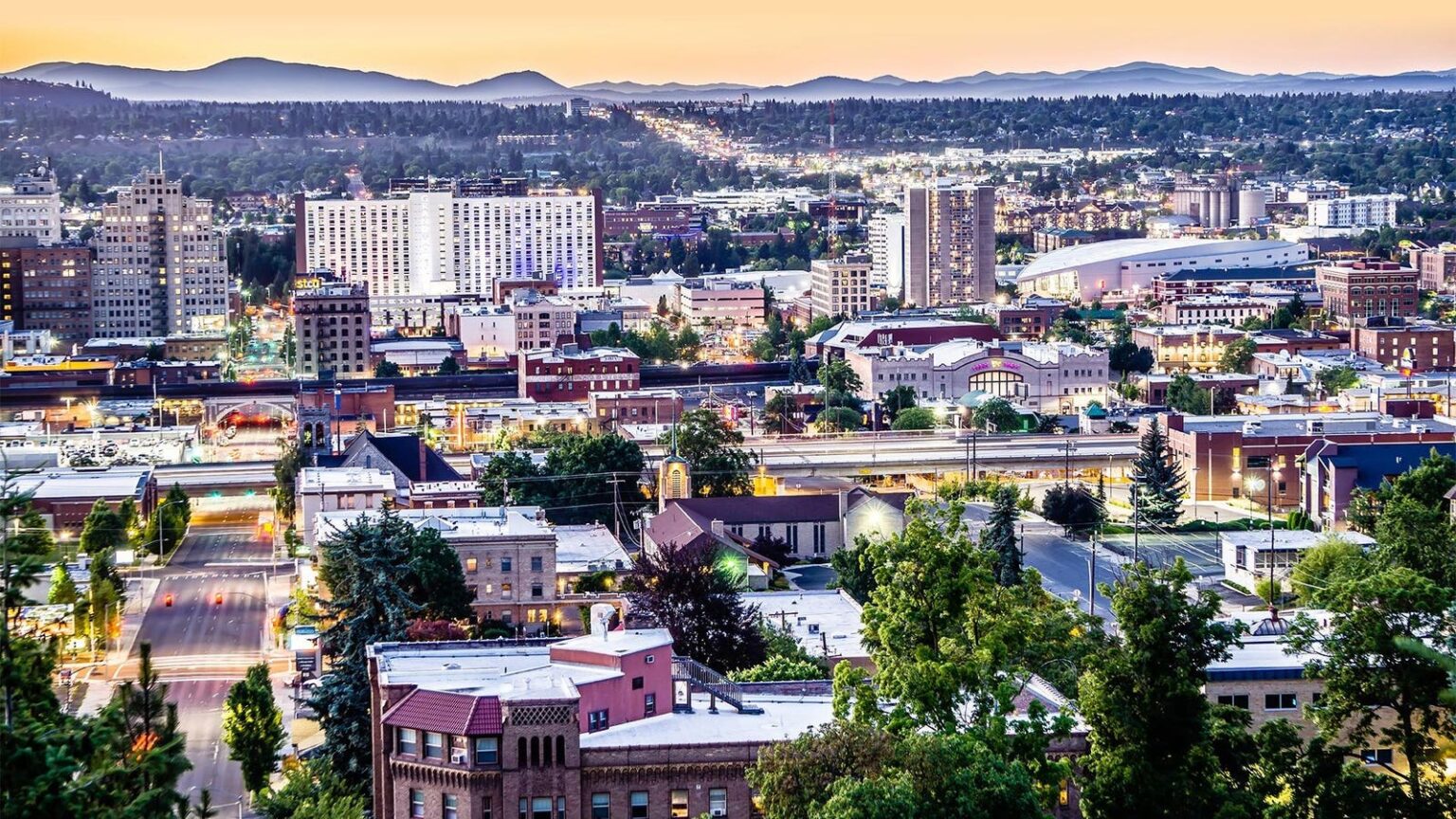Remote workers and retirees alike have flocked to scenic Spokane, driving up home prices. But the city is working through its growing pains.
By Emily Mason, Forbes Staff
Bruce Munholand spent 32 years working for the U.S. Army Corps of Engineers, mostly in Alaska, where he met his wife, Keri. His last posting was in St. Louis, managing the cleanup of a suburban waste site contaminated with radioactive materials from The Manhattan Project era. In early 2021, shortly after his retirement from the Corps, Bruce, now 71, and Keri, now 55, hooked up their side hustle—a cobalt blue 1969 Citroen van retrofitted in Europe to serve gourmet coffee—to their truck and drove 1,870 miles Northwest, over five days, to Spokane, Washington. They had picked the city for its natural beauty, reasonable costs, proximity to two of their three adult children (one in Seattle and one in Spokane) and coffee-consciousness. “Knowing that coffee was already a big deal in the Northwest, it was a business that we knew would travel,” says Keri.
These days, the Munholands position their Surge Coffee Co. van in downtown Spokane, by the 100-acre Riverfront Park (the site of the 1974 World’s Fair) and at sporting and other events. They dispense batch brews, mochas and chai lattes at $6 to $8 a cup and do about $70,000 a year in sales, donating all their tips to charities, including local and international Christian relief agencies. “I’ve always used repurposed as opposed to retired, because there’s always something to do,’’ says Bruce. They’re planning to add a second van serving ice cream from a local dairy and to eventually hire a professional manager so, as Keri puts it, “we can finally go to Italy.”
In recent years lots of folks have been hitting the trail to this eastern Washington enclave, 20 miles west of Idaho, in search of an outdoorsy and affordable lifestyle. The U.S. Census Bureau estimates that between 2010 and July 2023, the population of Spokane County grew 17% to 551,455, while the city of Spokane, the county seat, saw an 11% increase to 231,000.
It hasn’t all gone smoothly. Spokane’s housing supply was already running short when the Covid pandemic and work-from-home unleashed a new wave of arrivals. A 2021 study by the Spokane Association of Realtors found residential rental vacancies had fallen to 1% and starter homes were getting as many as 30 offers, with young locals being priced out of the market. That year, the mayor declared a housing emergency.
Between the time the Munholands decided on Spokane in 2017 and were ready to move in 2021, prices rose so fast and the housing supply got so tight, that they moved into a condo in South Perry, a once run-down city neighborhood that now boasts trendy restaurants and shops. (It’s a temporary solution; they’ve also bought two wooded acres just 10 minutes out of town, and are building a home using lots of Washington state wood.)
Three years after that emergency, Spokane is still grappling with the housing shortage. Median home prices in the county have risen by two thirds since 2019 and now hover around the national median of $394,000–but that’s still less than half the $879,000 median in Seattle, a prime source, along with pricey California, of migrant flow.
The fact that its housing prices are still comparatively reasonable, is one reason Spokane earned a spot on Forbes’ Best Places To Retire In 2024 list, which emphasizes quality living at an affordable price. Other factors that helped it make the list include good air quality, a low risk of natural hazards, plenty of primary care doctors, and no state income tax, except on certain capital gains in excess of $250,000 in a year. (Downsides include a higher-than-average crime rate, a state estate tax, cold winters, and only a so-so economy.)
As for lifestyle, the city is very bikeable and the area offers extensive hiking trails and seven public golf courses. Ski slopes are an hour away. Moreover, as the largest city in what’s known as the Inland Northwest, which includes eastern Washington and Oregon and Northern Idaho, Spokane tends to punch above its population weight when it comes to concerts, restaurants and sporting events. Spokane hosted both men and women’s college basketball games during March Madness and the men’s team at Gonzaga, the biggest local private university, has made it to the Sweet 16 of the NCAA tournament for nine years running. The Podium, a $53 million indoor sports facility, opened in 2021 adjacent to Riverfront Park. It’s designed to accommodate professional volleyball, basketball, wrestling and track events.
As for the housing shortage and meh economy, local leaders are working on it. The city has adopted new regulations to allow more units and eliminate parking requirements in residential areas. The idea is to allow more housing to be built in existing neighborhoods.
“Our goal is to dramatically ramp up our ability to build housing at all income levels, a lot of that will be dense urban housing, so that the quality of life can stay the same here,” says Spokane Mayor Lisa Brown, who ousted the incumbent last November promising to address the housing crisis, homelessness and a growing fentanyl drug problem. “It’s a high quality of life. I just don’t want it to go away due to the in-migration and the rising housing prices,” adds Brown, 67, a PhD economist whose resume includes stints as the state Senate’s first female Democratic majority leader and the first female chancellor of Washington State University, Spokane.
Before U.S. soldiers marched in during the 19th century, the Spokane River was a center of life for the Spokane Tribe, who lived a semi-nomadic life, taking salmon and steelhead from the river. Today, the tribe’s reservation is located roughly an hour northwest of downtown Spokane and houses a resort and two casinos.
The city itself was incorporated as Spokane Falls back in 1881, just as the railway was reaching town. It became a transportation hub for the gold and silver mining, timber and grain industries. Even today, trains can be seen and heard rattling on elevated tracks above downtown Spokane.
Signs of Spokane’s past—and its ongoing revitalization–abound. An old flour mill is now a boutique shopping center on the river that powered it. A defunct Wonder Bread factory (it produced Hostess cupcakes until 2000) has been turned into a food hall with regional chefs and coffee roasters. An abandoned rail yard across the Spokane River from downtown has been developed over the last 18 years into Kendall Yards, a mixed use urban district with apartments, homes, restaurants, a weekly open-air market in the warmer months and access to a 37-mile paved nature trail.
“There’s so much opportunity here for real estate development and taking advantage of the landscape,” Steve MacDonald, director of community and economic development for the city says over the sound of Spokane Falls—natural falls that were damned to produce power a century ago. He points to a parking lot for Canopy Credit Union occupying a prime piece of waterfront land. “That’s the old idea, ‘put the parking lot or put the factory next to the river,’ that will go away.”
The city has also been shaking off its long-time, distinctly Wild West reputation when it comes to fraud. The Spokane Stock Exchange, founded in 1897, was shuttered in 1991 under pressure from the SEC. (At the time of the closing, it was the country’s last regional exchange devoted to questionable penny stocks.) As recently as 2009, Forbes labeled Spokane the “Scam Capital of America.”
South of the river, in a Washington State University building, a handful of local entrepreneurs are practicing their investor pitches at an event hosted by the university’s incubator and LaunchPad INW, a local organization mentoring startups. They’re prepping to pitch investors like the Spokane Angel Alliance, a 19-year-old group of investors who have pumped $76 million into 75 tech and other startups. That’s small potatoes compared to the real venture capital money in Seattle, but it’s part of a continuing effort to move the local economy into the 21st century.
The locals are also pushing for a slice of the medical and healthcare industry; the Spokane County Health Sciences & Services Authority is offering to match up to $500,000 in federal grant funding for biotech and health sciences startups.
Not long ago, the University of Washington in Seattle had a near monopoly on medical education in the state. But in 2015, Washington State University won the state legislature’s backing to create a medical school in Spokane. It’s now fully accredited and named after Elson S. Floyd, the late Washington State president who pushed for it, with the idea of producing practitioners for underserved rural areas. Meanwhile, the University of Washington has set up a program with Gonzaga which allows 60 medical students to take the first 18 months of their training in Spokane, again with the idea of encouraging them to return to the Eastern part of the state.
Despite such efforts, Spokane County’s largest employer remains the Fairchild Air Force Base, which was first set up as an Army Depot during World War II and is now a medium-sized refueling base just west of Spokane International Airport. It’s been a source of young retirees as service members take a liking to the area and return (or stay) for their post-military years.
Kevin Williams was stationed at 11 different bases around the world during his 25 years as an administrative officer. He’d been at Fairchild for four years when he started thinking about his next assignment. “My son was a sophomore in high school and when it came time to think about if I was going to go on a little further (in the Air Force), he said, ‘Come on dad, we have to move again?’ which was perfectly understandable,” Williams recalls. “He really liked Spokane. I quickly recognized that I liked Spokane an awful lot, too.” Williams, now 54, was speaking as he bounced between booths at a job fair he helped organize as a vice president for Spokane Workforce Council, a non-profit which helps match employers and workers. Today, Williams’ son is 23 and recently graduated from Eastern Washington University with a major in finance. He plans to stay in Spokane.
A business organization that opened its first office in Spokane’s University District in April, gives a hint of how the area is evolving–slowly. In a county where 88% of residents are white, the office belongs to the multi-ethnic business association known as AHANA—an acronym for Asian, Hispanic, African, Native American. The organization was created back in 1998, but really grew during the pandemic with support from now Mayor Lisa Brown, who was then director of the Washington State Department of Commerce. She enlisted AHANA to make sure that business owners of color were getting their share of federal forgivable Paycheck Protection Program loans and other Covid relief efforts.
“The grants just started rolling in, continuing to be renewed and built during the pandemic,” marvels Marvo Reguindin, 67, executive director of AHANA since 2020. He was born in Seattle after his parents immigrated to the U.S. from the Philippines and lived in Hawaii, California and around the Pacific Northwest before landing in Spokane in 1991 and starting his own advertising and graphic design agency. (AHANA became a client.) Today, Reguindin lives in an up-and-coming Spokane neighborhood with his partner and two yorkies. He feels relatively safe in Spokane and has built a community there through his involvement with AHANA, the Inland Northwest Business Alliance and on LGBTQ issues.
But Reguindin raises an uncomfortable issue for outsiders thinking of moving to the area. In April, members of the University of Utah women’s basketball team, in Spokane to play in the NCAA tournament, were reportedly subjected to racial slurs when they went to a restaurant and their hotel in nearby Coeur D’Alene, Idaho. That popular resort town is in Kootenai County, where Richard Butler’s infamous white supremacist group, Aryan Nations, was founded in the 1970s and headquartered. (In 2000, a Coeur D’Alene jury returned a $6.3 million verdict that bankrupted Butler. His compound was sold and he died in 2004.)
“When I first got here, I wasn’t aware of the Aryan Nations issue in North Idaho and then quickly found out about it, and I’m like, ‘okay, I don’t go to Idaho unless I need to,’’ Reguindin says. “It’s changing and yet still the same.”
MORE FROM FORBES
Read the full article here










